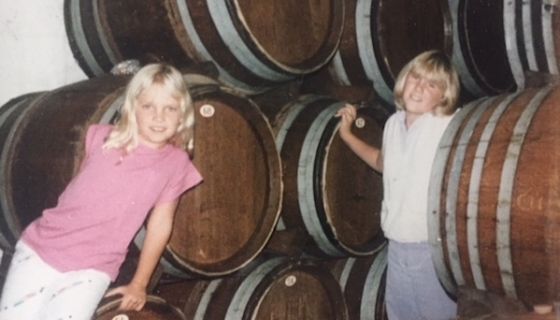My father started our small winery, Tulocay, in 1975, a year before I was born, so one could say I had an early indoctrination into the wine world. However, unlike the Anheuser-Busch family, who placed a drop of Budweiser on the tongue of the first-born male to instill a love of product, my sister and I didn’t taste Pinot Noir until well out of diapers. But our vinous surroundings were still imprinted in our identities. Pictures from the early years show my sister and me with must-soaked shirts during harvest, or mugging in front of stacks of barrels, or pushing each other around on the hand truck usually reserved for cases. As teens we worked on the Tulocay bottling line, an assembly-style set-up staffed with my dad’s always expansive group of friends and neighborhood kids looking to earn a dollar. The wine flowed, and so did the ribald stories and untoward jokes, and we teenagers admittedly learned more about two guys walking into a bar than we did about dissolved oxygen and fill heights.
Although my dad’s stated mission for our small, convivial winery was then and is now to “have fun,” I didn’t initially consider it as a career path. To a young person Napa felt insular, and even with stretches of vineyard as your backdrop and pilfered bottles of killer Zinfandel as your drink, it wasn’t seen by teenagers as the tourist destination touted in the magazines. If you grew up in Napa, or Crap-a, as my high school friends and I called it, you left for college. It was only after pursuing a career in other fields--biochemistry, public health, and epidemiology--did I come back to assist my dad with the winery.
I wouldn’t say that my adult conversion to the wine world was instantaneous, but there are many aspects of learning the wine process that appeal to a former lab rat, and much of that has to do with applying all those hours of organic chemistry classes to something that is fun to taste and smell and analyze, as opposed to say, a thread of DNA you’ve just isolated. And there were many memorable bottles consumed along the way. Two from my birth year: a beautiful magnum of 1976 Tulocay Pinot Noir opened on my 30th birthday and a 1976 trockenbeerenauslese brought to a class by a viticulture professor that smelled like Christmas distilled in a glass. But it wasn’t one bottle that sealed my path to quit my public health job in San Francisco and move to Napa with my four-year-old in tow. It was our cellar.
Our cellar is tiny, with a door that sticks a little at the corner when you try to open it. When my parents purchased our property in the early ‘70s, there were two old chicken houses on it, and my dad converted them to wine buildings. The cellar hasn’t changed much since then. It is nothing like the palatial up-valley wineries, with their dynamited hillsides, and unblemished barrels, and polished cave walls stretching for miles. Inside the small rectangular building our barrels are stacked two-high, and there is just enough room to fit them all, though not enough room to fit a forklift, necessitating moving barrels by hand. A black widow always seems to find her way under a keg I’m about to lift. Our cellar has, and builds, character.
Every cellar has its own smell, its own microbiome, and when I open our door I am swept up in our unique ecosystem, which smells of my youth and of much wine spilled and dried over the decades. It smells both intimately familiar and alluring, the primal landscape bridging my childhood environment with the present moment. Walking between barrels, smelling and tasting for the good and the bad, the rose petal and the animalia, for signs of fermentation or senescence, all the usual winery issues--the heat wave about to hit during harvest, the press that seems to always be on its last legs, the ever-rising cost of grapes--falls to the periphery. Instead there is potential energy: the nervy promise of a great wine in the midst, the evolution of elevage, the conversion of process into craft.
If there is a “genius loci” or spirit of place, I know it is not the smell of one wine but of the many in my cellar, the ones that came before and the ones yet to come.













